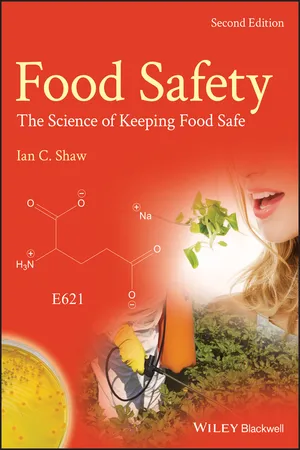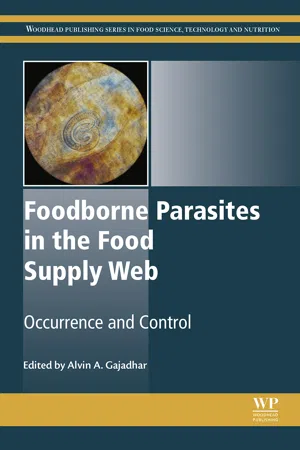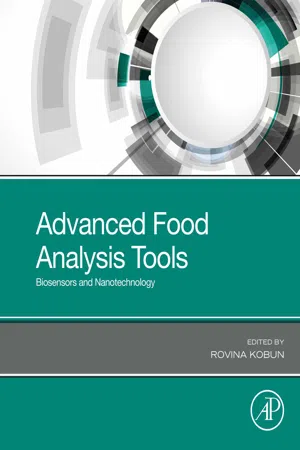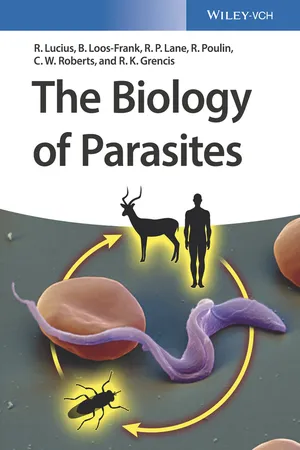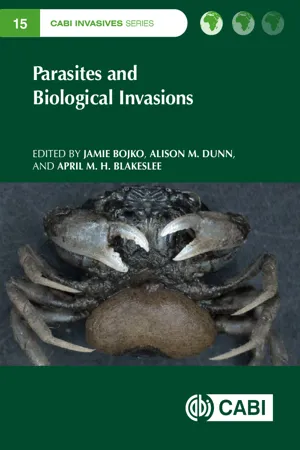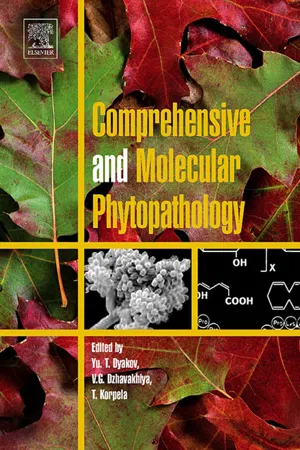Biological Sciences
Parasites in Food
"Parasites in food" refers to the presence of parasitic organisms in food products, which can pose health risks to consumers if ingested. These parasites can include protozoa, helminths, and other organisms that can cause infections and diseases. Proper food handling, cooking, and sanitation practices are essential for preventing the transmission of parasites through food consumption.
Written by Perlego with AI-assistance
7 Key excerpts on "Parasites in Food"
- eBook - ePub
Food Safety
The Science of Keeping Food Safe
- Ian C. Shaw(Author)
- 2018(Publication Date)
- Wiley-Blackwell(Publisher)
Chapter 5 ParasitesIntroduction
A parasite (from the Greek parasitos meaning a person who eats at the table of another) is an animal or plant that lives off a host animal or plant giving the host nothing in return. In this chapter I will only discuss animal parasites that have a human host and are transmitted via food.Food‐borne parasites often have complex lifecycles, part of which occurs in humans and part occurs in another animal; for this reason the food‐borne parasites are all zoonoses (i.e. can infect humans and animals and can be contracted from animals). All parasites are killed by cooking at sufficiently high temperatures.Parasite food‐borne illnesses are far more common in developing countries than in the developed world because of improvements in food hygiene over the past 50 years in the latter.There is a broad array of different parasites associated with food‐borne illnesses. Indeed they range from the simplest of single‐celled animals (e.g. Protozoa) to complex, highly adapted creatures (e.g. tapeworms). Therefore it is impossible to deal with the parasites as a single taxonomic group; for this reason I can't describe their discovery and history because each creature has an individual story.In this chapter I will deal with each biological group of food‐borne parasites separately.What are parasites?
Parasites comprise a broad array of different creatures all with one goal, to live for free! They utilise nutrients from another animal (or plant) – the host – and give nothing in return. Parasites in a food safety context have a human host as part of their complex lifecycles and are transmitted in food. They are all destroyed by cooking and so are only a problem in undercooked food (e.g. pork) or food eaten raw (e.g. fish sashimi).Food‐borne parasites are categorised as parasites because of their lifestyle (i.e. robbing their food from others) and not based on phylogenetics. For this reason parasites range from simple single‐celled animals (e.g. Giardia - eBook - ePub
Foodborne Parasites in the Food Supply Web
Occurrence and Control
- Alvin A Gajadhar(Author)
- 2015(Publication Date)
- Woodhead Publishing(Publisher)
A safe food supply is essential to the survival of humankind. As people have multiplied and technology has advanced, the food supply has evolved from a base of local consumer production to large-scale integrated production and distribution practices. Consumers, particularly those in urban regions, are largely unaware of the origin and processing of their food. Similarly, most producers are unaware of the variety of potential public health hazards that are transmissible by food. Both consumers and producers rely on government regulations and oversight for guidance and protection. Although information regarding foodborne hazards is widely available from many sources, especially regarding hazards such as bacteria and chemical residues, there is limited information on foodborne parasites. This is becoming an urgent matter as the food supply web is now global and expertise in parasitology in developed countries has waned. This complacency has been driven primarily by improved hygiene standards and the increasingly effective control of zoonotic Parasites in Food animals in those regions. This chapter introduces the diversity and unique characteristics of foodborne parasites, the food vehicles by which they are transmitted, and their significance to consumers. A ranking of these foodborne parasites by various socioeconomic factors and information relevant to their control are presented.The world’s population currently exceeds 7 billion consumers living in regions where foodborne parasites are endemic or where there is risk of infection from imported food. Yet, relatively little is known about parasites, and their identity and characteristics are often confused with those of bacteria and viruses. Parasites are eukaryotic organisms that are classified within diverse taxa ranging from single-cell protozoa to complex hermaphroditic helminths. Foodborne parasites that are prevalent globally or regionally include the flagellated protozoon Giardia, the coccidian protozoa Cryptosporidium and Toxoplasma , the roundworms (nematodes) Trichinella and Anisakis , the tapeworms (cestodes) Taenia and Echinococcus , and the flukes (trematodes) Opisthorchis , Clonorchis , and Fasciola - eBook - ePub
Advanced Food Analysis Tools
Biosensors and Nanotechnology
- Rovina Kobun(Author)
- 2020(Publication Date)
- Academic Press(Publisher)
Biosensors are analytical instruments that transform biological reactions to electrical signals and are deemed promising because of their specific properties such as high sensitivity, ease of miniaturization, and rapid response. Biosensor and nanotechnology progress has recently increased as leading research in several forms of industrial or educational industries and provides opportunities to boost the potential generation of biosensor innovations that will improve the mechanical, electrochemical, optical, and magnetic features of biosensors with high-performance biosensor arrays. Nanotechnology-enabled goods are rapidly commonplace and one of the most promising technological developments that have contributed to significant advances in the modern diet and food sciences. Biosensors and nanotechnologies are increasingly emerging in current areas such as food, forestry, biomedical, medicinal, and pharmaceutical sciences, catalysis, and environmental regeneration. Since biosensor has high sensitivity and reliability, which is improved by the usage of nanomaterials that have rendered it possible to incorporate in the field of parasitology. Recent advances in biosensor development over the last few years have paved the way for potential researchers to improve these biosensory aspects further and optimize them for the identification of dangerous diseases triggered by parasites.Classification of parasites
Parasites look like roundworms, gross-looking tapeworms, fleas, or blood-borne diseases (malaria and schistosomiasis) ranging from several centimeters to many meters in length. Their size is very small compared to their food sources, which can protect them from predators, and they often consume other living things. Parasites are species that receive food from other living organisms; therefore, a “good” or well-adapted parasite will not destroy its host, as it relies on the host to provide food consistently over a long period of time. In the meantime, according to Doyle (2013) , those parasites live only in one animal species. Nevertheless, other parasites, especially worms, invest their sexually reproductive lives in a primary or definite host and emerge as larvae in an intermediate host of different organisms during another part of their lives.The protozoan parasite is a completely different class of eukaryotic organisms that can cause disease in living organisms. Robertson (2018) discovered that the majority of parasitic infections are asymptomatic, induce acute short-lived, as well as remain in the body causing chronic effects. This situation can be considered confined to tropical countries, primarily in areas with minimal sanitary facilities where the communities are typically eating raw and undercooked food. Generally, the transmission occurs through various sampling techniques, preparation routines, detection targets used, as well as through a variety of routes and vehicles, including soil, water, food, and human-animal contact (Ortega & Sterling, 2018 ; Rozycki et al., 2020 - eBook - ePub
- Richard Lucius, Brigitte Loos-Frank, Richard P. Lane, Robert Poulin, Craig Roberts, Richard K. Grencis, Ron Shankland, Renate FitzRoy(Authors)
- 2017(Publication Date)
- Wiley-VCH(Publisher)
virulentus = full of poison), which was originally a means of assessing a pathogen's degree of aggressiveness. Unfortunately, the same term is used by evolutionary biologists to refer to the parasite's effect on host genetic fitness. From a physiological perspective, the host is therefore not only harmed by food deprivation – the destruction of cells or tissues through the action of toxic metabolic products and immune responses that harm the host's own tissue (immunopathology) also cause damage. It used to be thought that phylogenetically ancient parasite–host relationships should be characterized by a relatively low pathogenicity, since parasites which only minimally harm their hosts may persist longer over the course of evolution. However, following both theoretical work and experimental studies with fast-evolving pathogens, it is now accepted that the pathogenicity (or virulence in its evolutionary sense) of parasites can increase over the course of evolution. Indeed, under a range of circumstances, natural selection can favor aggressive exploitation of the host, resulting in high parasite replication and transmission rates, at the expense of long-term host survival.1.1.5 Modes of Transmission
Due to the different varieties of parasitic organisms, modes of transmission are very diverse. The simplest form of transmission is by direct contact, for example, through contact with the skin, such as in mites or lice. One special case of contact infection is sexual transmission, as in the case of infections caused by Trichomonas vaginalis and Trypanosoma equiperdum.Many life cycles of parasites are based on oral infection, that is, the intake of infective stages via the mouth. Intake can occur via the food chain and foodstuff – a process known as alimentary infection, or in ecological terms, trophic transmission. Some of these cycles are based on a predator–prey relationship between the intermediate and definitive hosts (e.g., catching of mice by the final host, the fox, which simultaneously ingests metacestodes of Echinococcus multilocularis, the fox tapeworm). Transmission from an intermediate host to a plant-eating definitive host requires a slight adjustment; here, the parasite stages leave the intermediate host to encyst on food plants (Fasciola hepatica: encystment on wetland plants). Infection by fecal-oral contamination occurs when infective stages derived from feces (e.g., amoeba cysts, coccidia oocysts, and nematode eggs) are ingested orally; diverse media such as contaminated water, food, and air (airborne transmission) can be used as transmission media. Since transmission is usually left to chance in fecal-oral infections, large numbers of infective stages are typically produced by parasites using this route (e.g., several billion Cryptosporidium parvum oocysts per kilogram of cattle dung). Infections occurring through other body orifices such as the nose, ear, eye, rectum, genital apertures, and wounds are less common. One important decisive factor in whether or not infective stages are successful in transmission is their persistence - eBook - ePub
- Dennis Jacobs, Mark Fox, Lynda Gibbons, Carlos Hermosilla(Authors)
- 2015(Publication Date)
- Wiley-Blackwell(Publisher)
Parasitoidism: two species living together as in parasitism except that the host invariably dies (or is at least rendered incapable of functioning) once the parasitoid has extracted the sustenance it needs for that stage of its development. Familiar examples include parasitoidal wasps used in horticulture that lay their eggs on or in other insects to provide a food-source for their larvae.Parasitism implies nutritional dependence on the host for at least part of the life-cycle. It also involves a high degree of specialised adaptation as the animal body is not a passive ecological niche (like a rotten tree-trunk harbouring beetles, for example) but is responsive and hostile to foreign invasion. A parasite must be able to overcome host defences and evade immunological attack. Mechanisms must also be in place to ensure transfer of infection, both geographically from host to host (‘horizontal transmission’) and temporally from generation to generation (‘vertical transmission’). This often entails an intricate integration of the life-cycle of the parasite with that of its host.Parasites can themselves be victims or beneficiaries of invading organisms. Fleas, for example, are exploited by larval stages of both tapeworms and nematodes, while the canine heartworm, Dirofilaria, is metabolically dependent on a symbiotic bacterium, Wohlbachia.1.2.2 Classification
The unwise student could approach every parasitic infection as a separate entity, but this would be an enormous task and a very inefficient approach to learning. It would soon become apparent that similarities exist between some diseases and this would prompt the question: ‘what are the common factors?’ So, classification is an inherent attribute of human curiosity. It has been noted already that Veterinary Parasitology embraces at least three types of arthropod, several types of protozoa and at least three types of parasitic worm, and so the value of classifying aetiological agents of disease is already becoming apparent.Taxonomy is a powerful and essential component of biological understanding, although, from a clinician’s viewpoint, it is a tool rather than an end in itself. Knowledge of the relationship between parasites often allows similarities in life-cycle, epidemiology, pathogenesis and drug susceptibility to be predicted. Thus, if used intelligently, classification provides a valuable framework for learning and reduces considerably the amount that has to be committed to memory. The classification in this book is kept at the simplest level compatible with this objective. - eBook - ePub
- Jamie Bojko, Alison M Dunn, April M H Blakeslee(Authors)
- 2023(Publication Date)
- CAB International(Publisher)
Understanding where invasive parasites sit within policy frameworks is important when exploring their risk in the context of global food security (Stentiford et al., 2014). Achieving global food security remains one of the biggest challenges facing humanity in the 21st century. Food security is defined by the Food and Agriculture Organization of the United Nations (FAO) as a condition that exists when ‘all people, at all times have physical and economic access to sufficient, safe and nutritious food that meets their dietary needs and food preferences for an active and healthy life’ (FAO, 1996, p. 5). Food production systems can involve agriculture, aquaculture, fisheries, wild resources of game animals or wild harvestable plants. Several factors have placed unprecedented pressures on global food production systems. The introduction of parasites with IAS is one of particular importance, since climate change and increased global connectivity are leading to an ever-increasing number of IAS introductions (Seebens et al., 2017; Chapter 8, this volume). The avenues of disease emergence and spread connected to biological invasions are therefore of critical importance to global food security. In this chapter, first we explore the interactions between IAS and their co-introduced parasites and food production systems (sections 9.2 and 9.3), detailing three different categories of interaction: (i) direct; (ii) intermediate; and (iii) indirect. This is followed by details of the ecological, economic and societal impacts on food security (sections 9.4 – 9.6), and consideration of the management and policy implications of parasites introduced with IAS (section 9.7) - eBook - ePub
- Yuri Dyakov, Vitaly Dzhavakhiya, Timo Korpela(Authors)
- 2007(Publication Date)
- Elsevier Science(Publisher)
All these aspects are integrated in the focus on studying interaction between a higher and lower organism, host plant and parasite. Without knowledge, analysis, and practical use of this interaction, even the most resistant cultivars will rapidly lose resistance, and the most active fungicides will become inefficient.Passage contains an image
Chapter 0Overview on parasitism
Yu. T DyakovPublisher Summary
The chapter describes parasitism. Parasitism is the ability of an organism to develop in/on another organism while consuming the host’s nutrients for its own growth and reproduction. Plants can host various species of parasites: fungal, bacterial, viral, and so on. They can be isolated and identified. In a living plant, we observe obligate parasites, facultative saprotrophs, and much less frequently, facultative parasites. In a dead plant, we can find obligate saprotrophs, facultative parasites, and less frequently, facultative saprotrophs. To explain these facts, the chapter discusses the essential features of parasites. According to the type of feeding, microorganisms are classified into saprotrophs, necrotrophs, and biotrophs. Saprotrophs extract nutrients from dead tissues, that is, they are saprophytes, while necrotrophs and biotrophs are parasites. Necrotrophs kill a plant or its part with toxic secretion before occupying it, which actually means that they feed on dead cells, similar to saprophytes. Biotrophs extract nutrients directly from living cells. This type of nutrition causes considerable changes in a parasite’s metabolism and morphogenesis. Therefore, trophicity is an important taxonomic property for dividing some bacterial and fungal species. Pathogenicity is the main feature of pathogenic organisms. Pathogenicity is viewed as a complex trait distinguishing parasites from nonparasites or the ability to cause damage in the infected plant.Types of host–parasite relationship
Organisms in ecosystems can interact with each other in different ways as shown in Table 0.1 . Apparently, two organisms in direct contact, or in chemical contact through extracellular metabolites cannot avoid the interaction. Zeroes in Table 0.1
Index pages curate the most relevant extracts from our library of academic textbooks. They’ve been created using an in-house natural language model (NLM), each adding context and meaning to key research topics.
Explore more topic indexes
Explore more topic indexes
1 of 6
Explore more topic indexes
1 of 4
